GP29
| Location: Macalister Research Farm. | Australian Soil Classification: Hypocalcic, Mesonatric, Red SODOSOL. |
| Geology: Quaternary prior stream deposits. | General Landscape Description: Level plain. |
| Soil Mapping Unit: Sale. | Site Description: Irrigated dairy grazing paddock. Laser graded six years ago. |
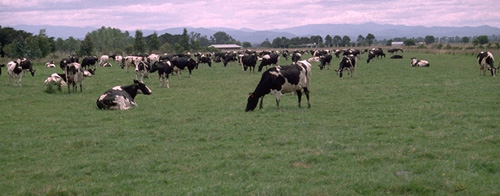 GP29 Landscape |
| Surface Soil | 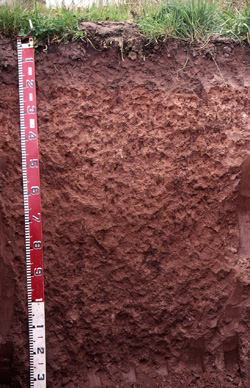 GP29 Profile GP29 Profile | ||
| A1 | 0-15 cm | Brown (7.5YR4/2); fine sandy loam; firm consistence dry; compacted layer; pH 5.6; sharp change to: | |
| Subsoil | |||
| B21 | 15-45 cm | Yellowish red (5YR4/6) with dark stains along root channels; light clay; moderate to strong coarse blocky, parting to moderate medium blocky structure (shiny faced peds); strong consistence dry; contains very few (<2%) carbonate and silica nodules (5 cm in size); pH 8.8: | |
| B22 | 45-80 cm | Yellowish red (5YR4/6) with dark stains along root channels; fine sandy light clay;weakly structured; contains very few (<2%) carbonate and silica nodules (5 cm in size); many pore spaces; pH 8.9: | |
| B23 | 80 -110 cm | Reddish brown (5YR5/4); fine sandy light clay; weak structure; contains very few (<2%) carbonate and silica nodules (5 cm in size); many pore spaces; pH 8.9: | |
| B24 | 110+ cm | Reddish brown (5YR5/4); fine sandy light clay; weak to moderate prismatic structure; contains a few (5%) carbonate and silica nodules (5-10 cm in size); pH 9.0. |
Key Profile Features:
- Strong texture contrast between the surface (A) horizon (14% clay) and sodic subsoil (B21) horizon (38% clay).
- Accumulation of calcareous nodules throughout the subsoil.
Soil Profile Characteristics:
Horizon | pH | Salinity Rating | ||
Surface (A1 horizon) | moderately acid | low | sodic | none 1 |
Subsoil (B21 horizon) | strongly alkaline | medium | strongly sodic | moderate |
Deeper subsoil (at 90 cm) | strongly alkaline | high | strongly sodic | moderate 2 |
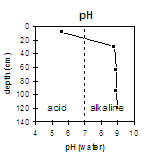 | 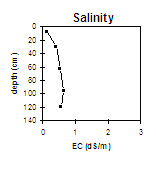 | 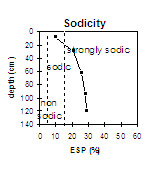 | 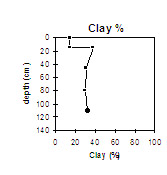 |
The surface soil is mod-erately acid. The subsoil is strongly alkaline throughout | The surface has a low salinity rating. The subsoil has a moderate rating; becoming high at 1 metre. | The surface soil is sodic, while the subsoil is strongly sodic throughout . | There is a sharp increase in clay content at the A/B horizon interface. |
Horizon | Horizon Depth (cm) | pH (water) | pH (CaCl2) | EC dS/m | NaCl | Exchangeable Cations | |||
Ca | Mg | K | Na | ||||||
meq/100g | |||||||||
A1 | 0-15 | 5.6 | 4.9 | 0.13 | 1.6 | 1.3 | 0.33 | 0.33 | |
B21 | 15-45 | 8.8 | 8.1 | 0.42 | 0.05 | 3.4 | 6.3 | 0.2 | 2.6 |
B22 | 45-80 | 8.9 | 8.2 | 0.52 | 0.11 | 2.5 | 5 | 0.2 | 2.6 |
B23 | 80-110 | 8.9 | 8.2 | 0.65 | 0.14 | 2.2 | 5 | 0.2 | 2.8 |
B24 | 110+ | 9 | 8.2 | 0.56 | 0.12 | 2 | 4.9 | 0.2 | 2.9 |
Horizon | Horizon Depth (cm) | Exchangeable Aluminium mg/kg | Exchangeable Acidity meq/100g | Field Capacity pF2.5 | Wilting Point pF4.2 | Coarse Sand (0.2-2.0 mm) | Fine Sand (0.02-0.2 mm) | Silt (0.002-0.02 mm) | Clay (<0.002 mm) |
A1 | 0-15 | 10 | 6.3 | 23 | 5 | 2 | 57 | 26 | 14 |
B21 | 15-45 | 30 | 17 | 0 | 32 | 29 | 38 | ||
B22 | 45-80 | 30 | 12 | 0 | 36 | 24 | 31 | ||
B23 | 80-110 | 30 | 11 | 0 | 31 | 41 | 30 | ||
B24 | 110+ | 31 | 12 | 1 | 24 | 45 | 32 |
Management Considerations:
Surface (A) Horizon
- The surface soil has a high fine sand content (57%). When cultivated in a dry condition it will become ‘powdery’ and subsequent rainfall may result in surface sealing occurring. Soils such as these rely to a large extent on organic matter for maintaining aggregation. The levels of organic carbon measured at the pit site were low (which may or may not be representative of the whole paddock). Organic matter levels will build up under pasture but will decline if cropping takes place. Practices such as residue retention, minimum tillage and pasture rotations could be utilised if cropping takes place in order to build up organic matter.
- The surface soil is sodic and there is slight dispersion after remoulding. This indicates that some structural degradation (e.g. surface sealing, increased cloddiness) may occur if the soil is cultivated or overstocked in a moist to wet condition. Also, raindrop action on bare surface soil may also promote dispersion and a hardsetting condition. Surface cover should be maintained to protect against raindrop damage.
- The low wilting point value (5.4) of the surface horizon indicates that plants will be able to utilise very light rains when the soil is dry. However, due to the low water storage capacity, plants will soon suffer moisture stress unless further rainfall occurs.
- The coarsely structured subsoil is strongly sodic and has a low exchangeable calcium to magnesium ratio (i.e. 0.6). Moderate dispersion in water occurs as a result. Root and water movement into the subsoil is likely to be restricted due to these conditions.
- The subsoil is strongly alkaline throughout. This suggests that some nutrients (e.g. iron, manganese, zinc, copper) may be poorly available to plants and that deficiencies may occur. Deficiencies can be determined by plant tissue analysis rather than soil analysis.
- The subsoil has a moderate salinity rating at 15 cm. This may restrict the growth of highly salt sensitive plant species. The salinity rating becomes high in the deeper subsoil which may restrict the growth of deeper rooted salt sensitive species.


